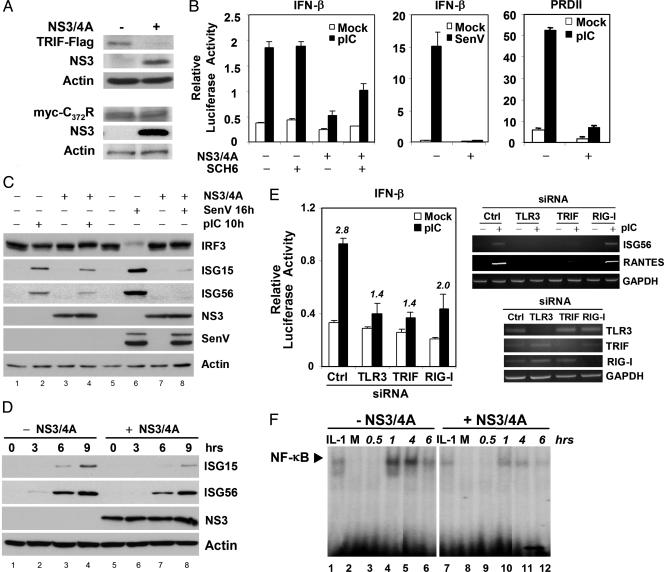Fig. 3.
TRIF proteolysis inhibits pIC-induced activation of IFN-β and PRDII promoters and ISG expression in UNS3-4A-24 cells that conditionally express NS3/4A. (A) Immunoblots showing abundance of transfected TRIF-Flag (Upper) and the cleavage-resistant myc-TRIF-C372R mutant (Lower) with or without NS3/4A expression. (B) IFN-β (Left) and PRDII (Right) promoter activities 8 h after addition of pIC to the media (50 μg/ml). For comparison, IFN-β promoter activity is also shown 16 h after Sendai virus (SenV) infection (Center). Where indicated, cells were treated with 10 μM SCH6. (C) Immunoblot detection of IRF-3, ISG15, and ISG56 after pIC exposure (10 h) or SenV infection (16 h). (D) ISG15 and ISG56 expression with (lanes 5–8) and without (lanes 1–4) NS3/4A expression at various times after the addition of pIC to media. (E) (Left) pIC stimulation of the IFN-β promoter is inhibited by RNA interference silencing of TLR3 and TRIF and, to a lesser extent, RIG-I. Numbers over each column pair indicate the fold-induction of promoter activity by pIC. Ctrl, control siRNA. (Upper Right) RT-PCR assays showing that RNA interference silencing of TLR3 and TRIF, but not RIG-I, prevents pIC induction of ISG56 and RANTES transcription. (Lower Right) RT-PCR detection of TLR3, TRIF, and RIG-I mRNAs after transfection of specific siRNAs. Cells were cultured in the presence of tetracycline (no NS3/4A expression). (F) EMSA demonstrating that NS3/4A expression attenuates pIC stimulated NF-κB binding to the PRDII element. IL-1, IL-1 treatment control; M, mock-treated.

